I haven't provided detailed commentary on the US labour market for a while now. To…
Careful before you leap!
The triumphalism of British Chancellor George Osborne in recent weeks, as a modicum of positive economic news seeps out of the – Old Dart – or should I say Britain (given the Old Dart strictly refers to England), is almost too much to bear. Moreover, stand ready for a phalanx of I-told-you-so-mainstream-economists coming out in force lecturing all and sundry about the benefits of fiscal austerity. These characters have been hanging tough for any sign of growth (they have been waiting some years) so they could all chime in that austerity has created the conditions for the growth. They choose to misunderstand any evidence that might cast doubt on that (spurious) correlation. The reality is very different. Austerity has undermined growth and retarded the economies where it has been imposed. All economies eventually resume growth. But the legacy of the policy failure will remain for years to come. All I can say to these triumphal ones is – Careful before you leap!
Here is the reality check. The following graph shows the evolution of real GDP in index number form, where the base period is the peak prior to the downturn. So for the US the peak was the December-2000 quarter, and for the UK and the Eurozone the peak quarter was March 2008.
The US economy is around 4.5 per cent larger than it was in December 2007.
You can see that the US economy passed the previous peak level of real GDP in the June-quarter 2011 (after 15 quarters) whereas the Eurozone and the UK remain at around 3 to 3.5 per cent below the previous peak after 22 quarters.
In other words, after 5.5 years since the last peak, the UK and EU17 economies have not yet wiped out the ground lost. You can also see that after showing signs of recovery (under the support of the fiscal expansion), both economies went down hill again under the weight of discretionary fiscal austerity.
That is clear from the following series of graphs.
The data for the EU17 comes from the – ECB Statistical Data Warehouse – although in one graph I show the IMF measure of the structural deficit (as a per cent of potential output), which comes from the – World Economic Outlook database (as at April 2013).
The data from the US comes from the Bureau of Economic Analysis (real GDP), the Bureau of Labor Statistics (Unemployment rates) and the Congressional Budget Office (Budget data).
The data for Britain comes from the Office of National Statistics.
Britain
The first graph shows the evolution of the public sector net borrowing (read) in £ billions in the UK (left-hand axis) and the real GDP growth rate (annualised) on the right-hand axis from the March-quarter 1999 to the June-quarter 2013.
Public sector net borrowing is equivalent to the net spending position (or deficit). You can see that after an attempt to run budget surplus led to a slowdown in real GDP growth in the early part of the current century, the stable deficit that followed maintained positive real GDP growth.
Then all hell broke out and the deficit increased dramatically because the loss of tax revenue pushed the automatic stabilisers into action and the national Labour government introduced discretionary fiscal stimulus.
The lagged response in real GDP growth was evidence as the deficit was growing.
But then in early-to-mid 2010, upon the election of the new national government – and all the fiscal austerity talk – real GDP growth started to collapse again.
From that point, the British government was running a pro-cyclical fiscal stance – that is, trying to cut net spending at a time the economy was slowing again – to the point that it drove the British economy back into recession.
It is also the case that the deficit has not been eliminated, which means that it is still providing some support to growth.
Note also that the current growth coincides with a rising net borrowing (that is, austerity is being relaxed). That reversal has clearly provided for higher private sector savings and provided some stimulus to growth.
So, be careful before you leap!
The next graph replaces the real GDP growth rate with the unemployment rate (right-axis). Up to the point of the crisis, the two series move together and the divergence as the crisis unfolded is entirely predictable and normal given the rising unemployment rate was due to a collapse in aggregate demand, which in turn undermined the tax revenue for the UK government (and so the deficit rose quite apart from the discretionary stimulus that was introduced.
Then you can see the austerity reversal and the pro-cyclical fiscal stance led to the unemployment rate rising steadily until the more recent period where some modest reductions have been had as a result of the austerity reversal.
Eurozone
The two graphs that follow repeat the same sort of analysis for the Eurozone (except the fiscal position is the actual deficit/surplus as a per cent of GDP).
Once again, the sudden and deliberate reversal of the expansionary fiscal stance in the March-quarter 2010 as the Troika was set loose resulted in a massive collapse in real GDP growth.
The slight lag in response in real GDP growth occurred because it took a while for the austerity drive to sink into production (and private spending) behaviour.
As the austerity is tapering in the recent quarters, it is expected that real GDP growth will resume, albeit modestly, unless the deficits are ramped up significantly.
In terms of the unemployment graph, the same pro-cyclical pattern is evident. The dotted line is the IMFs estimate of the structural deficit (which you can take with a grain of salt – it is almost certainly biased on the excessive side). But it behaves in the same way as the official deficit measure.
The US
Finally, you can see the reason why the real GDP growth indexes in the opening graph are so different. The first graph shows that the fiscal stimulus in the US was maintained for much longer allowing the private savings to recover more strongly. The US government has largely avoided a pro-cyclical fiscal stance which sets it apart from the UK and the Eurozone.
It is clear that the reduction in the deficit has been possible as a result of positive real GDP growth, which has delivered increased tax revenue.
The final graph shows the evolution of the unemployment rate and the budget position. Again there is no evidence of a pro-cyclical fiscal stance being imposed.
Conclusion
This is not to say that the conduct of fiscal policy in the US has been ideal. It is clear that the deficit has been politically constrained and should have been much larger – perhaps twice as large.
But this blog is about comparisons and it is clear that the governments in the UK and the Eurozone have adopted fiscal stances which are the anathema to sound practice – that is, they have eschewed all standard macroeconomic thinking and imposed pro-cyclical policy positions and the evidence is there for all to see.
As Robert Skidelsky noted last week in his article – Osborne may gloat about recovery, but his “hard slog” will leave Britain worse off:
Economies always recover from their low points, whatever the policies pursued, sooner or later. Things happen, in the country or in the world, to revive business’s “animal spirits”. The question is whether they happen sooner or later and how long the recoveries last. Here, policy does matter.
There is no evidence to support the crowing triumphalism that the conservatives will start dishing up over the next few months.
The policy-induced situation in the UK and the Eurozone remains abysmal. Both economies might be starting to pop their heads above the water but the damage that austerity has wreaked is too large to even contemplate right now.
That is enough for today!
(c) Copyright 2013 Bill Mitchell. All Rights Reserved.
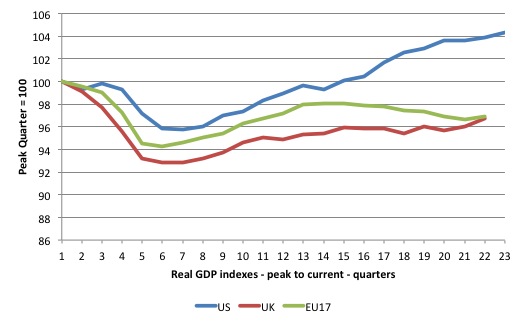
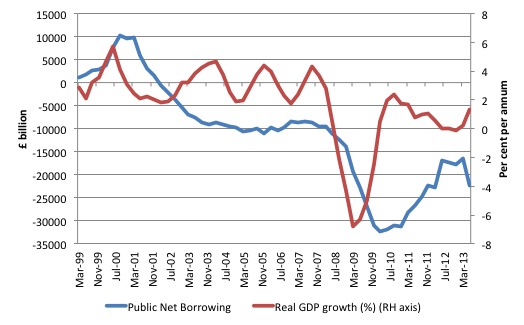
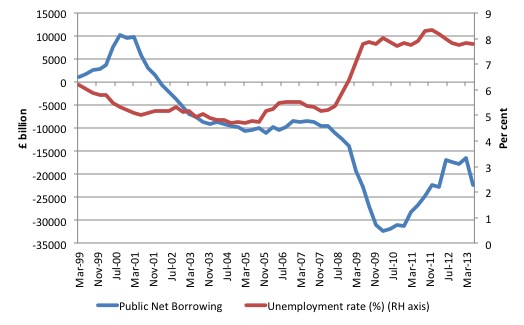
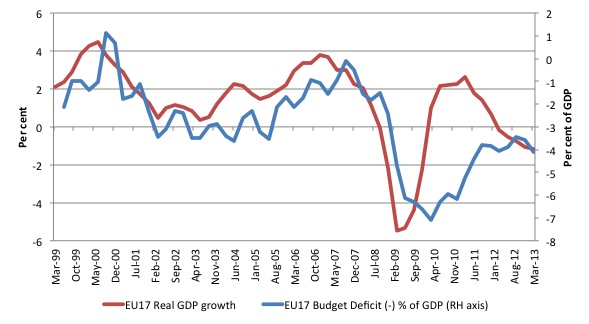
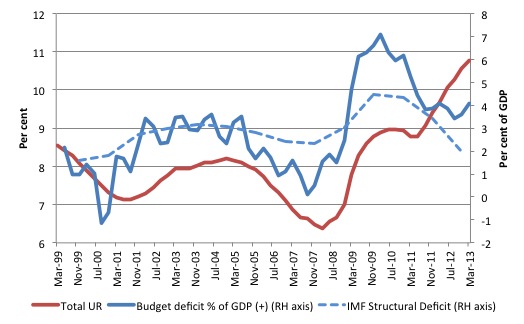
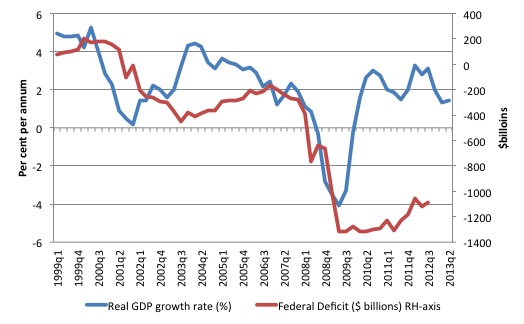
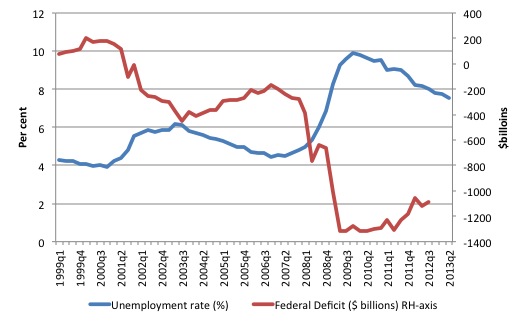
Re Skidelsky’s claim that “Economies always recover from their low points…”, he would certainly seem to be right, but I’ve always wondered exactly what the MECHANISM is that brings that recovery. All I can think of is Say’s law. But it’s widely accepted that Say’s law works in a very slow and inefficient manner in a complex money based economy.
But presumably that’s it: economies eventually recover thanks to Say’s law working in a slow and inefficient manner.
There’s more pro-austerity twaddle recently been published by that well known liar and incompetent, Kenneth Rogoff. You’ll need access to the Financial Times, but it’s here:
http://www.ft.com/cms/s/0/b933e5e8-29ef-11e3-9bc6-00144feab7de.html#axzz2h7p7F1Ew
As Simon Wren-Lewis (Oxford economics prof) points out, Rogoff bases his argument on the assumption that a monetarily sovereign country cannot or won’t print money. See:
http://mainlymacro.blogspot.co.uk/2013/10/ken-rogoff-on-uk-austerity.html
But I’d go further. Having read several of Rogoff and Reinhart’s articles, it’s plain as a pikestaff to me that R&R don’t EVEN UNDERSTAND that a monetarily sovereign country can print.
Rogoff and Reinhart are S-E-R-I-O-U-S-L-Y S-T-U-P-I-D.
Are we really sure that economies always recover? What are we to make then of the myriads of lost cities and civilisations history is littered with, fresh examples of which routinely continue to turn up? We really have no idea what happened to consign these peoples to history. For all we know many of them might, for reasons unknown, represent examples of economies which never made it out of depression.
As long as there is some level of net government spending there will growth, however small. Of course the total level of spending has a lot to do with how much economic activity will occur.
Under a balanced budget scheme, practically speaking overall growth should be impossible mathematically assuming balanced trade. If growth occurred under these conditions there would have to be some kind of spending expansion we don’t know about.
“Economies always recover from their low points…”
If you ‘believe’ J. Warner: “What’s more, to the extent that it is growing again, it seems to be largely down to government spending.”
http://www.telegraph.co.uk/finance/comment/jeremy-warner/10362016/Jeremy-Warner-Investment-and-exports-are-missing-ingredients-in-the-recipe-for-prosperity.html#disqus_thread
If you ‘believe’ D. Weldon: “Output is growing at a healthier pace but it is being led by consumption, that consumption is fueled by borrowing and may be associated with a pickup in the property market.”
http://touchstoneblog.org.uk/2013/10/the-state-of-the-recovery
Nothing to do with Say’s Law in this case?
On closer examination of the UK’s second quarter data, things do not look nearly so rosey. Private investment is down significantly for qtr 1 and 2. Exports rose in qtr 2, but so did imports. What pathetic growth we have had has been down to a combination of Household consumption (partly fuelled by an 5.4% increase in unsecured household debt), and inventory accumulation.
With the minimum wage raised just 2%, and average wage growth (about 1.5%) falling behind inflation, and with the £ rebounding, I can’t see Osborne’s tiny good news holding.
Ralph.
Deficit spending surely and bank bailing which eventually leads to increased activity via more private debt.
i prefer SFC to SAY
” All I can think of is Say’s law. ”
It’s expectations of others speculative behaviour. Eventually enough speculative follies succeed to generate a critical mass. People talk to each other. We don’t exist in the splendid isolation. Ultimately the optimists are proved right – there is food over yonder hill.
I have £20 in my wallet I haven’t spent in a week. Because I don’t desire any products at the moment. That’s Says law put to bed there and then.
i guess the distinction (or correlation) between business investment and household demand becomes important here. Investment provides savings triggers demand but why invest if you calculate your investment will just pay down debt ? Deficit spending or redistributive taxation/ spending cures that, either quickly or, under protest, not so quickly.
As a layman, I don’t pretend to understand a lot of the more detailed explanations of correlations between GDP and public spending and I become somewhat skeptical of correlation graphs which include left and right axes put to scale against one another (damn statistics).
But always, the most sensible and striking correlation is that of public spending and unemployment. It speaks so clearly of the falling in demand and the knock on effect that has on business.
Postkey,
Although government consumption was up over the last 2 quarters, public investment was down by more than that. Warner has said that GFCF is up recently, but it is down. The whole “improvement” is down to household consumption and increased household debt.
Kind Regards
Charles,
Thanks for that.
This was pointed out on the Keiser Report.
“Banks operating in the U.K. had set aside billions of pounds to compensate customers who’d been been sold insurance that would pay their mortgages, for example, if they were fired or got sick.
The Office for Budget Responsibility, the government’s official forecaster, said that the compensation was so big it would provide “some short-term support to household consumption growth.” One economist, Alan Clarke at Scotiabank, says the compensation payments have been more successful at stimulating the U.K. economy than quantitative easing. U.K. lenders have already paid £11.5 billion ($18.7 billion) to millions of customers, and have set aside another £7.3 billion for future payments.
But the payments are not just creating one-off windfalls: the PPI industry is also creating much-needed employment.
As we report over on WSJ.com, claims have been coming in at such a clip that it’s created tens of thousands of new jobs to handle them.”
http://blogs.wsj.com/moneybeat/2013/10/04/how-a-banking-scandal-is-bolstering-britains-economy/
Well I totally disagree with him, and do agree with the school of Keynesian thought that Austerity and stimulus should go hand in hand simultaneously and always. It is the allocation of stimulus and austerity targets that counts. USA chooses to stimulate the rich Capitalist 1% dreaming of a “trickle down” rhetoric they invented to mean “trickle out” into their profits pocket, war machinery the vehicle. For austerity they choose to impoverish more with “Entitlements” another rhetoric choice for starving and reduction rates the vehicle, ignoring the potential of “trickle up” profits from domestic consumption and relying on legal rhetoric trickery in the international agreements fields to try and create export opportunity and import reduction even illegal barriers the vehicle. Uk and EU have chosen the opposite scenario and it is paying off as the first chart shows stability and renewed infrastructure the result USA has totally lost with $3tr infrastructure shortfall as the chart shows for a 4% GDP growth that went 11% TO THE RICHEST 1% IN 2012. By fiat money and loaned to create a domestic consumption lie that will end in more foreclosure and greater poverty increasing the 60% poor to 75% by loss of the middle class altogether
In other words, after 5.5 years since the last peak, the UK and EU17 economies have not yet wiped out the ground lost. You can also see that after showing signs of recovery (under the support of the fiscal expansion), both economies went down hill again under the weight of discretionary fiscal austerity. Rob Carter NB: In the same time USA has lost all ground and infrastructure went to war costs adding to the 9/11 disaster cost. You live on peaks EU & UK well know that leaves you USA with the disasters of quake, shake, avalanche and like as you proselytize the bible you ignore the “strong foundation” building proverbs.
The next graph replaces the real GDP growth rate with the unemployment rate (right-axis). Up to the point of the crisis, the two series move together and the divergence as the crisis unfolded is entirely predictable and normal given the rising unemployment rate was due to a collapse in aggregate demand, which in turn undermined the tax revenue for the UK government (and so the deficit rose quite apart from the discretionary stimulus that was introduced. Rob Carter NB: Ah! But whereas UK uses a real unemployment rate USA uses an entirely phony 7%-8% benefit recipient rate, whereas their real unemployment exceeds 22% and underemployment far worse. Furthermore USA is where the foreclosures bankrupt people before and next year again.
I’ll leave it there you are just plain wrong and will be proven so between 2014 and 2019 depression fully on Professor Kondratiev timing 2029 if not 2020 due to accelerated digital life. Bush wars ensure you will remain a fiat Nation on strife. Then by 2050 USA Un-industrial revolution to de-mechanize to replace fossil fuel gobblers with domestic consumer man wage and end reliance on exporting War.